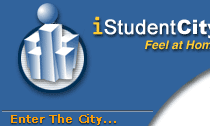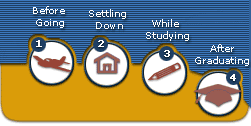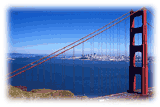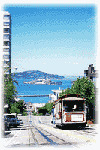 |
 |
 |
 |
 |
 |
 |
| Privacy Policy |
| Disclaimer |
| Terms & Conditions |
|
Study in USA: San Francisco by Way Yu
Schools in the area Students have been calling the Bay Area home since the late 1800s. The two most well-known schools in the vicinity, Stanford University and University of California at Berkeley, may be separated by a body of water, but rivalry is fierce and long-standing. It was just a few years ago that the annual football game between the two schools ended in a small riot and an injured mascot.
On the weekends, the campus is relatively quiet. Students rely on dorm and club parties for fun since neighboring areas appeal more to wealthy citizens than student budgets: Downtown Palo Alto and neighboring Menlo Park (where America's wealthiest venture capital firms are headquartered) only offer upscale restaurants and boutiques. For getaways, students can shell out a few dollars and hop on the one-hour train to SF.
Cal is as famous for its academics as it is for its liberal atmosphere. Student protests are a staple here--walk into main plaza and you'll witness demonstrations, see flyers announcing a cause, and more. The surrounding neighborhoods offer many after-class diversions. The city of Berkeley was founded to support the educational institution, and thus, many of the local shops and restaurants were set up to appeal to students and their budgets. The homeless are also very visible here, and actually have become as much a part of the background as the vendors hawking incense on the street. Within San Francisco are many other top universities, including the only two UC schools without undergraduate programs: the research hospital and medical school UCSF, and UC Hastings Law School. Large universities in the area include Golden Gate University, San Francisco State University and University of San Francisco. There are also a score of smaller private colleges as well, like St. Mary's College in Moraga (15 minutes east of Berkeley). Where to Live San Francisco is California's take on cosmopolitans. Like New York City, this city was built upwards so that the skyline is filled with tall skyscrapers. Houses are built side-by-side, without a garden or fence to separate them. But like Los Angeles, San Francisco benefits from beautiful weather almost year-round and is surrounded by diverse landscapes. Beaches, snow-capped mountains and hiking trails are all within a few hours drive. Most importantly, SF embodies the West Coast spirit of innovation. This place, where tech companies mingle easily with financial bastions, feels like new money. San Francisco's diverse nature attracts all types of people, and the neighborhoods reflect this. Deciding where to live takes almost as much research as picking which school to enroll in since each area has its own distinct personality. The choice of neighborhood may already be decided for you if you are a student and must live within walking distance of your school. Berkeley may be grungy, but student demand for housing has created high rents. Rooms are generally small since many of the buildings are old. Expect to pay at least $700 for a one-bedroom in one the older buildings. Other cheaper alternatives are co-ops or renting a room in a nearby Berkeley Hills or Emeryville home. At Stanford, on-campus housing is provided for most of its students. This works out well, considering the neighboring areas are affluent. Rents for one-bedrooms range between $800 to $1200. Looking for a place within the city? Unfortunately, pricing is more often the determining factor than the neighborhood itself. Since the number of people moving to San Francisco is greater than the number leaving, a housing shortage has been created. Nob Hill is a perfect place to begin your search. Many apartments here offers great views of the city. Because of its proximity to the major areas of the city (North Beach, Union Square, and the Financial District), studios here start at $1200. A side note: it's very likely that your next door neighbor here is a financial analyst. The further down the hill you go, the less expensive rent will be. Russian Hill, Laurel Heights and Pacific Heights are also good areas to check out. Apartments will be slightly more affordable, and just a few blocks further from the city's main attractions. North Beach is the Little Italy of San Francisco, with streets lined with delis, Italian restaurants and coffeehouses. When the sun sets, these restaurants come alive with music and crowds. Because of its vivid nightlife, North Beach is a desirable location for 20-somethings. However, open apartments are rare, and rents can be higher than Nob Hill. Younger crowds also reside in the Haight-Ashbury and Western Addition areas. The apartments here are reasonably-priced, and the community is more liberal than most. The western portions of the city, like the Sunset and Castro districts, are generally more family-oriented and quieter. Apartments are more scarce: one and two-story duplexes and houses populate this area, and renting one will start at $1500 and more. If you're not getting the help you'd like from the University's housing office, consider looking online. Savvy San Franciscans use Craig's List to search for roommates and apartment openings. Life in the City
Once you can navigate the city, you'll want to know where to find the fun stuff. Shopaholics will no doubt head first towards Union Square. Many big-name designers and stores have opened up their West Coast flagship stores here. For trinkets, the alleys of Chinatown are overflowing with interesting items. If you're into vintage items, you'll want to check out Haight-Ashbury. If you are the outdoors type, bike rides around the marina or hikes in the mountains north of the Golden Gate Bridge will let you exercise and enjoy the weather and views at the same time. Sports enthusiasts can cheer on any of the local sports teams, like the 49'ers (football) or A's (baseball). Is dancing more your thing? Bars and clubs dot the city and are especially plentiful in North Beach, Union Square and the area below the financial district called SOMA (South of Market). Fortunately, many are within walking distance of one another, so instead of calling a cab, you can hop from one place to the next to figure out which one you like best. Be warned however, that entrance and drink prices in the city are high and not friendly to the student budget. For art lovers, San Francisco boasts of many major museums, like the Museum of Modern Art, and off-the-wall galleries, which can be found in Haight-Ashbury and near Fisherman's Wharf. The SF Opera House and San Francisco Symphony draws sophisticated crowds to its dome-shaped performance hall. Live music clubs playing jazz, blues and rock can be found in the Union Square and North Beach areas. There are also many one-day road trips to go on. Monterey's aquarium, Carmel's golf courses, Santa Cruz's boardwalk, Napa Valley's wineries and even Lake Tahoe's ski slopes are all within a few hours and therefore easily accessible by car. Chefs around the world have declared San Francisco one of the best cities for food. Produce is always fresh because of SF's proximity to the coast (for seafood) and Central California Valley (for vegetables and beef). You'll find many upscale restaurants in the area, including Chez Panisse (creator of "California cuisine") and French Laundry, which many have proclaimed the best French restaurant in the United States. Likewise, you'll want to sample dim sum and tiramisu here since the city is a great for cultural dining. Check out North Beach (Italian), Chinatown, Little Tokyo, and the Mission District (Mexican) for affordable ethnic eats. If you'd rather cook meals yourself, you're in for a treat. Because of the sophisticated palates of San Franciscan, ethnic grocery stores and chain supermarkets alike stock up on the best and freshest ingredients. Many restaurants also offer cooking classes to help you along the way.
| ||
 |
| ||||||||||||||||||||||||||||||
|
| ||||||||||||||||||||||||||||||
Home | About iStudentCity | Job Opportunities | Contact iStudentCity Hall
Copyright©2000-2009, iStudentCity.com. All Rights Reserved.
 Falling in love with San Francisco is a risk you'll have to take if you move here. The city,
with its steep hills and daily fog, is filled with small treasures in each of its neighborhoods.
It's no wonder that Frank Sinatra crooned that he "left his heart" here in the city by the Bay.
Falling in love with San Francisco is a risk you'll have to take if you move here. The city,
with its steep hills and daily fog, is filled with small treasures in each of its neighborhoods.
It's no wonder that Frank Sinatra crooned that he "left his heart" here in the city by the Bay.

 If Stanford students are known for being khaki-clad yuppies, then UC Berkeley's are generalized as
left-wing bohemians. Founded in 1868,
If Stanford students are known for being khaki-clad yuppies, then UC Berkeley's are generalized as
left-wing bohemians. Founded in 1868,  Getting around shouldn't be a problem. Like NYC, this is a walkable city. Public transportation is
also fairly reliable. (Besides, driving is a headache because of high gas prices, steep hills and
one-way streets.)
Getting around shouldn't be a problem. Like NYC, this is a walkable city. Public transportation is
also fairly reliable. (Besides, driving is a headache because of high gas prices, steep hills and
one-way streets.)  By all means, explore the city and get to know each of the neighborhoods. The city is so diverse that
this article only skims the surface of what's around. Despite the cold weather and urban grunginess,
you'll be pleasantly surprised at what you find. Locals may put their nose in the air, but you'll be
so enraptured by the city's charms, you might not notice.
By all means, explore the city and get to know each of the neighborhoods. The city is so diverse that
this article only skims the surface of what's around. Despite the cold weather and urban grunginess,
you'll be pleasantly surprised at what you find. Locals may put their nose in the air, but you'll be
so enraptured by the city's charms, you might not notice.
